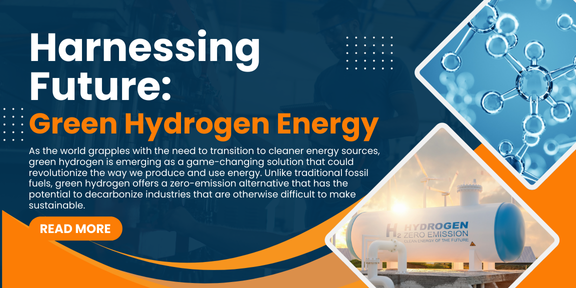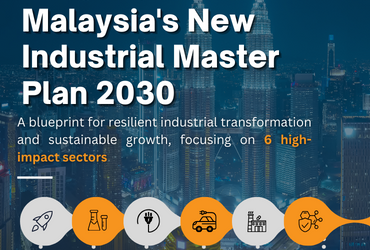
As the world grapples with the need to transition to cleaner energy sources, green hydrogen is emerging as a game-changing solution that could revolutionize the way we produce and use energy. Unlike traditional fossil fuels, green hydrogen offers a zero-emission alternative that has the potential to decarbonize industries that are otherwise difficult to make sustainable.
Malaysia has recognized hydrogen as a crucial component in its journey toward net-zero carbon emissions, as demonstrated by the National Energy Transition Roadmap (NETR) introduced by the Ministry of Economy in July 2023 and the Hydrogen Economy Technology Roadmap (HETR) launched in October 2023.
Classification of Hydrogen Energy
Hydrogen is the most abundant element in the universe and can be used as a clean fuel source. However, not all hydrogen is created equal. Hydrogen is categorized by colors based on how it is produced:
- Green Hydrogen: Produced using renewable energy sources (like wind or solar) to power electrolysis, which splits water into hydrogen and oxygen without emitting greenhouse gases.
- Blue Hydrogen: Produced from natural gas but with carbon capture and storage (CCS) to reduce emissions.
- Grey Hydrogen: Produced from fossil fuels (mainly natural gas) without carbon capture, resulting in significant CO2 emissions.
Among these, green hydrogen is the cleanest form, offering a truly zero-emission fuel that can help achieve net-zero targets.
The Role of Green Hydrogen in Decarbonizing Industries
Green hydrogen’s versatility makes it particularly valuable in sectors that are hard to decarbonize through direct electrification alone. Here are some of its critical applications:
- Heavy Industry (Steel, Cement, Chemicals): Green hydrogen can replace coal and natural gas in industrial processes like steelmaking, where it can serve as a reducing agent, significantly lowering CO₂ emissions.
- Transportation: Green hydrogen can be used as a fuel for fuel cell electric vehicles (FCEVs), especially in sectors like trucking, shipping, and aviation, where battery electric solutions are less practical due to weight and range limitations.
- Power Generation and Energy Storage: Hydrogen can be stored and then converted back into electricity using fuel cells or combustion turbines, providing a way to store renewable energy and stabilize grids with high levels of intermittent sources.
- Heating and Cooling: Green hydrogen can be blended with natural gas or used directly for heating residential, commercial, and industrial spaces, reducing reliance on fossil fuels.
Challenges Facing Green Hydrogen
Despite its promise, green hydrogen faces several challenges that must be addressed for widespread adoption. High production costs make it more expensive than blue or grey hydrogen, primarily due to the cost of electrolyzers and renewable electricity. Additionally, the current lack of infrastructure for hydrogen production, storage, and distribution presents significant barriers. Electrolysis, the process used to produce green hydrogen, is energy-intensive, and its overall efficiency in converting electricity to hydrogen and back to usable energy can be lower compared to direct electrification. Finally, scaling up production to achieve economies of scale will require substantial investments in large-scale facilities and supportive government policies.
Hydrogen Project in Malaysia
Malaysia’s energy roadmap positions Sarawak as a regional hub for green hydrogen, with plans to develop three integrated projects to produce green hydrogen in the state. This includes the establishment of a green hydrogen production plant in Kuching by 2025 for domestic use and two additional plants in Bintulu by 2027, primarily for the export market.
In 2019, Sarawak launched an integrated hydrogen production plant and refueling station in Kuching and introduced the state’s first hydrogen-powered vehicles. This initiative allowed Sarawak Energy, the state-owned electric utility, to explore hydrogen’s potential as part of the state’s energy mix.
A hydrogen-based power plant is also planned for Sabah, including within the Brunei Darussalam–Indonesia–Malaysia–Philippines East ASEAN Growth Area (BIMP-EAGA), utilizing ocean water to produce 100% green hydrogen. The project aims to develop new energy sources, focusing on integrated hydrogen-based and solar photovoltaic (PV) power plants for the region. Pilot sites in Sabah include Tuaran, Kota Belud, Kudat, and Kota Marudu, with plans to commercialize the technology by integrating it into existing grid systems and off-grid setups.
Green hydrogen represents a crucial piece of the puzzle in the fight against climate change. By leveraging renewable energy to produce a clean and versatile fuel, green hydrogen has the potential to decarbonize sectors that are currently dependent on fossil fuels, driving us closer to a sustainable future.
Identify investment opportunities – Phillip Managed Account for Retirement (PMART) and Phillip Managed Account (PMA) ESG
Phillip Capital Malaysia offers discretionary portfolio that invests in stocks with high ESG ratings from the F4GBM and F4GBMS Indices, namely PMART and PMA ESG. There are both conventional and Shariah options available. PMART and PMA ESG is suitable for investors who want to optimise the risk-adjusted return by constructing a diverse sustainable portfolio of ESG companies.
To explore the companies in which both Conventional and Shariah ESG mandates invest, you can refer to the provided link. We like these companies because they have received high ESG ratings, which we believe can contribute to their long-term sustainability, responsibility, and profitability.
Please click on the link to learn more or email us at cse.my@phillipcapital.com.my if you require any further information.
Disclaimer:
The information contained herein does not constitute an offer, invitation or solicitation to invest in Phillip Capital Management Sdn Bhd (“PCM”). This article has been reviewed and endorsed by the Executive Director (ED) of PCM. This article has not been reviewed by The Securities Commission Malaysia (SC). No part of this document may be circulated or reproduced without prior permission of PCM. This is not a collective investment scheme / unit trust fund. Any investment product or service offered by PCM is not obligations of, deposits in or guaranteed by PCM. Past performance is not necessarily indicative of future returns. Investments are subject to investment risks, including the possible loss of the principal amount invested. Investors should note that the value of the investment may rise as well as decline. If investors are in any doubt about any feature or nature of the investment, they should consult PCM to obtain further information including on the fees and charges involved before investing or seek other professional advice for their specific investment needs or financial situations. Whilst we have taken all reasonable care to ensure that the information contained in this publication is accurate, it does not guarantee the accuracy or completeness of this publication. Any information, opinion and views contained herein are subject to change without notice. We have not given any consideration to and have not made any investigation on your investment objectives, financial situation or your particular needs. Accordingly, no warranty whatsoever is given and no liability whatsoever is accepted for any loss arising whether directly or indirectly as a result of any persons acting on such information and advice.






